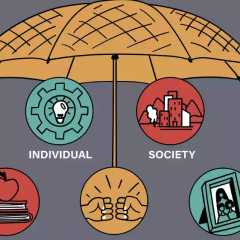Understanding about what protects against involvement in violent extremism and terrorism is in its infancy. Little concerted attention has been paid to developing a conceptual, theoretical or empirically informed account of how, when and why protective factors work. To begin to address these gaps in the research base, this report presents a preliminary model for conceptualising how protective factors might work in relation to violent extremism.
Research on protective factors in relation to terrorism and violent extremism is limited.
Relatively little empirical research has focused specifically on protective factors.
There is considerable ambiguity as to how protective factors should be conceptualised.
They have been interpreted as:
- Reducing risk factors
- The absence of risk factors
- Buffers that mitigate risk factors
- Conceptually distinct and unrelated to risk factors
The means by which protective factors might shape pathways into and out of terrorism are likely to be complex. Their influence may differ according to:
- The stage of engagement in extremism at which they are experienced
- The ways in which they interact with other factors
- The potential to exhibit non-linear effects on levels of risk
Rather than interpreting protective factors in isolation, there are benefits from approaching protective factors holistically, taking account of the ways they interact and operate across micro, meso and macro levels.
To develop a better understanding of protective factors, it is helpful to examine the processes and mechanisms by which they work; situate risk and protection in broader social contexts such as subcultures; and understand how values and norms influence which and how protective factors might work.
Conceptualising Protective Factors
To address the conceptual challenges facing research on protective factors, this report sets out a preliminary model for interpreting protective factors.
The framework is informed by a review of research on protective factors set out in an accompanying report: Protective Factors for Violent Extremism and Terrorism: Rapid Evidence Assessment (Marsden and Lee, 2022).
Theoretically, the model is underpinned by strengths-based approaches to interpreting offending behaviour and reflects the following characteristics:
- It follows research which suggests the Good Lives Model (GLM) has the potential to help explain how and why protective factors may work. The GLM assumes we all seek to pursue different configurations of ‘goods’, such as relatedness, community or agency. Offending (including terrorism offending) is considered a maladaptive means of achieving these goods and is influenced by obstacles to attaining them legally. This approach helps identify which goods matter in individual cases and may help interpret pathways into terrorism and violent extremism by identifying obstacles that make it difficult to achieve goods normatively and legally.
- The GLM proposes that there are four obstacles that shape pathways towards offending: use of inappropriate means, for example using harmful or illegal ways of achieving goals; a lack of coherence in the way different goods relate to one another; a lack of scope, where particular goods come to dominate others; and insufficient capacity, when an individual’s internal capacities, or external circumstances mean it’s difficult to achieve primary goods legally.
- Strengths-based approaches such as the GLM adopt a more holistic perspective than risk-oriented perspectives because they take greater account of the social-ecological context and how it interacts with individual level characteristics.
- Engaging in extremist subcultures can be understood as a way of deploying strengths in pursuit of goods which might otherwise be difficult to attain.
- Social-ecological and extremist subcultural contexts influence values and norms; shape which goods are important; and provide opportunities to pursue them.
- Protective factors include individual cognitive, psychological or behavioural capacities and external capacities reflected in an individual’s social-ecological context which enable people to pursue goods legally.
- Protective mechanisms are the broader processes by which protective factors operate. They are visible in relation to the four obstacles which undermine people’s ability to achieve goods normatively.
- Protective mechanisms work to realign or rebalance the coherence and scope of someone’s goals; change attitudes or access to the means of achieving goods legally; and increase someone’s capacity to attain goods without causing harm.
- The context within which goods can be pursued may be legal or illegal.
- Participation in extremist subcultures is through goal-directed practices which provide direct or indirect routes to achieving goods. Violence or criminality are only some of the possible outcomes of this process.
- Protection may be afforded through the opportunities extremist contexts provide to pursue goods through counter-normative but legal routes, where these satisfy the individual’s most significant goals. For example, someone’s desire to pursue the good of relatedness by developing close social ties in an extremist context could be met without the need to engage in violence or criminality.
Next Steps
To assess whether this framework helps explain how protective factors and constraints on terrorist offending work, future work will benefit from:
- Understanding the subcultural dynamics that:
- Provide opportunities to pursue goods by mapping the roles or goal-directed practices they make available.
- Shape values and norms that might act as constraints and understand whether these provide opportunities for people to achieve goods in ways that sustain non-violent engagement and/ or perform a protective function.
- Test the assumptions of the Good Lives Model to determine:
- Whether involvement in terrorism can be understood as a means of achieving primary goods.
- If obstacles to achieving goods legally help explain pathways into terrorism.
- How protective mechanisms function in relation to terrorism offending.
- Whether obstacles to achieving goods help explain re-engagement.
Read more
Abbiati, M., Golay, P., Gasser, J., & Moulin, V. (2020). Protective Factor Assessments: What Are We Measuring? An Investigation of the Internal Validity of the Structured Assessment of Protective Factors for Violence Risk. Criminal Justice and Behavior, 47(4), 383-398.
Acevedo, G. A., & Chaudhary, A. R. (2015). Religion, Cultural Clash, and Muslim American Attitudes About Politically Motivated Violence. Journal for the Scientific Study of Religion, 54(2), 242–260. https://doi.org/10.1111/jssr.12185
Adam-Troian, J., Bonetto, E., Araujo, M., Baidada, O., Celebi, E., Dono Martin, M., Eadeh, F., Godefroidt, A., Halabi, S., Mahfud, Y., Varet, F., & Yurtbakan, T. (2020). Positive associations between anomia and intentions to engage in political violence: Cross-cultural evidence from four countries. Peace and Conflict: Journal of Peace Psychology, 26(2), 217–223. https://doi.org/10.1037/pac0000385
Agnew, R. (2010). A general strain theory of terrorism. Theoretical Criminology, 14(2), 131–153. https://doi.org/10.1177/1362480609350163
Altier et al. (2017). Why they leave: An analysis of terrorist disengagement Events from eighty-seven autobiographical accounts. Security Studies, 26(2), 305-332.
Altunbas, Y., & Thornton, J. (2011). Are Homegrown Islamic Terrorists Different? Some UK Evidence. Southern Economic Journal, 78(2), 262–272. https://doi.org/10.4284/0038-4038-78.2.262
Asal, V., Fair, C. C., & Shellman, S. (2008). Consenting to a Child’s Decision to Join a Jihad: Insights from a Survey of Militant Families in Pakistan. Studies in Conflict & Terrorism, 31(11), 973–994. https://doi.org/10.1080/1057610080 2400201
Baier, D., Manzoni, P., & Bergmann, M. C. (2016). Influencing Factors of Political Extremism in Adolescence. MONATSSCHRIFT FUR KRIMINOLOGIE UND STRAFRECHTSREFORM, 99(3), 171-198.
Barnes-Lee, A. R. (2020). Development of protective factors for reducing juvenile reoffending: a strengths-based approach to risk assessment. Criminal Justice and Behavior, 47(11), 1371-1389.
Bartlett, J., & Miller, C. (2012). The Edge of Violence: Towards Telling the Difference Between Violent and Non-Violent Radicalization. Terrorism and Political Violence, 24(1), 1–21. https://doi.org/10.1080/09546553.2011.594923
Berger, L. (2016). Local, National and Global Islam: Religious Guidance and European Muslim Public Opinion on Political Radicalism and Social Conservatism. West European Politics, 39(2), 205–228. https://doi.org/10.1080/01402382.2015.1062252
Berrebi, C. (2007). Evidence about the Link Between Education, Poverty and Terrorism among Palestinians. Peace Economics, Peace Science and Public Policy, 13(1), 38.
Bhui, K., Silva, M. J., Topciu, R. A., & Jones, E. (2016). Pathways to sympathies for violent protest and terrorism. British Journal of Psychiatry, 209(6), 483–490. https://doi.org/10.1192/bjp.bp.116.185173
Bhui, K., Everitt, B., & Jones, E. (2014). Might Depression, Psychosocial Adversity, and Limited Social Assets Explain Vulnerability to and Resistance against Violent Radicalisation? PLoS ONE, 9(9), e105918. https://doi.org/10.1371/journal.pone.0105918
Boehnke, K., Hagan, J., & Hefler, G. (1998). On the Development of Xenophobia in Germany: The Adolescent Years. Journal of Social Issues, 54(3), 585–602. https://doi.org/10.1111/j.1540-4560.1998.tb01237.x
Bonta, J. & Andrews, D. A. (2017). The psychology of criminal conduct (6th ed.). New York, NY: Routledge.
Bonta, J., & Andrews, D. A. (2003). A commentary on Ward and Stewart’s model of human needs. Psychology, Crime & Law, 9(3), 215–218. https://doi.org/10.1080/10683/16031000112115
Bouhana, N. (2019). The moral ecology of extremism: A systemic perspective. Paper prepared for the Commission for Countering Extremism. Retrieved from https://assets.publishing.service.gov.uk/government/uploadssystem/uploads/attachment_data/file/834354/Bouhana-The-moral-ecology-of- extremism.pdf.
Cardeli, E., Sideridis, G., Lincoln, A. K., Abdi, S. M., & Ellis, B. H. (2020). Social bonds in the diaspora: The application of social control theory to somali refugee young adults in resettlement. Psychology of Violence, 10(1), 18. https://doi.org/10.1037/vio0000259
Charkawi, W., Dunn, K., & Bliuc, A.-M. (2021). The influences of social identity and perceptions of injustice on support to violent extremism. Behavioral Sciences of Terrorism and Political Aggression, 13(3), 177–196. https://doi.org/10.1080/19434472.2020.1734046
Cherney, A. & Belton, E. (2020). Assessing intervention outcomes targeting radicalised offenders: Testing the pro integration model of extremist disengagement as an evaluation tool. Dynamics of Asymmetric Conflict, 13(3), 193-211.
Cherney, A., & Murphy, K. (2019). Support for Terrorism: The Role of Beliefs in Jihad and Institutional Responses to Terrorism. Terrorism and Political Violence, 31(5),1049–1069. https://doi.org/10.1080/09546553.2017.1313735
Clemmow, C., Schumann, S., Salman, N. L., & Gill, P. (2020). The base rate study: developing base rates for risk factors and indicators for engagement in violent extremism. Journal of forensic sciences, 65(3), 865-881.
Cording, J. R., & Christofferson, S. M. B. (2017). Theoretical and practical issues for the measurement of protective factors. Aggression and violent behavior, 32, 45-54.
Corner, E., Bouhana, N., & Gill, P. (2019). The multifinality of vulnerability indicators in lone-actor terrorism. Psychology, Crime & Law, 25(2), 111-132.
Corner, E., Gill, P., & Mason, O. (2016). Mental Health Disorders and the Terrorist: A Research Note Probing Selection Effects and Disorder Prevalence. Studies in Conflict & Terrorism, 39(6), 560–568. https://doi.org/10.1080/ 1057610X.2015.1120099
Costello, M., Hawdon, J., Ratliff, T., & Grantham, T. (2016). Who views online extremism? Individual attributes leading to exposure. Computers in Human Behavior, 63, 311–320. https://doi.org/10.1016/j.chb.2016.05.033
Cragin, K., Bradley, M., Robinson, E., & Steinberg, P. (2015). What Factors Cause Youth to Reject Violent Extremism? Results of an Exploratory Analysis in the West Bank. RAND Corporation. https://doi.org/10.7249/RR1118
Dawson, L. L. (2017). Sketch of a social ecology model for explaining homegrown terrorist radicalisation. The International Centre for Counter-Terrorism–The Hague, Research Note, 8(1).
de Vries Robbé, M. (2014). Protective factors: Validation of the structured assessment of protective factors for violence risk in forensic psychiatry. Radbound University Nijmegen.
de Vries Robbé, M., & Willis, G. M. (2017). Assessment of protective factors in clinical practice. Aggression and Violent Behavior, 32, 55–63
Dean, C. (2014). The Healthy Identity Intervention: The UK’s development of a psychologically informed intervention to address extremist offending. In Silke, A. (ed.) Prisons, Terrorism & Extremism, Critical Issues in Management, Radicalisation and Reform. London: Routledge.
Decker, S. H., & Pyrooz, D. C. (2019). Activism and Radicalism in Prison: Measurement and Correlates in a Large Sample of Inmates in Texas. Justice Quarterly, 36(5), 787–815. https://doi.org/10.1080/07418825.2018.1462396
Delia Deckard, N., & Jacobson, D. (2015). The prosperous hardliner: Affluence, fundamentalism, and radicalization in Western European Muslim communities. Social Compass, 62(3), 412–433. https://doi.org/10.1177/0037768615587827
Desmarais, S. L., Simons-Rudolph, J., Brugh, C. S., Schilling, E., & Hoggan, C. (2017). The state of scientific knowledge regarding factors associated with terrorism. Journal of Threat Assessment and Management, 4(4), 180–209. https://doi.org/10.1037/tam0000090
De Waele, M., & Pauwels, L. J. R. (2016). Why Do Flemish Youth Participate in Right-Wing Disruptive Groups? In C. L. Maxson & F.-A. Esbensen (Eds.), Gang Transitions and Transformations in an International Context (pp. 173–200). Springer International Publishing. https://doi.org/10.1007/978-3-319-29602-9_10
Dickson, S. R., Willis, G. M., & Mather, D. (2018). Protective factors and the good lives model: Combining positive approaches to assessment and treatment. In New Frontiers in Offender Treatment (pp. 43-56). Springer: Cham.
Doosje, B., Bos, K. van den, Loseman, A., Feddes, A. R., & Mann, L. (2012). “My In-group is Superior!”: Susceptibility for Radical Right-wing Attitudes and Behaviors in Dutch Youth. Negotiation and Conflict Management Research, 5(3), 253–268. https://doi.org/10.1111/j.1750-4716.2012.00099.x
Doosje, B., Loseman, A., & Bos, K. van den. (2013). Determinants of Radicalization of Islamic Youth in the Netherlands: Personal Uncertainty, Perceived Injustice, and Perceived Group Threat. Journal of Social Issues, 69(3), 586–604. https://doi.org/10.1111/josi.12030
Durrant, R. (2017). Why do protective factors protect? An evolutionary developmental perspective. Aggression and Violent Behavior, 32, 4–10.
Ellis, B. H., Sideridis, G., Miller, A. B., Abdi, S. M., & Winer, J. P. (2019). Trauma, Trust in Government, and Social Connection: How Social Context Shapes Attitudes Related to the Use of Ideologically or Politically Motivated Violence. Studies in Conflict & Terrorism, 1–18. https://doi.org/10.1080/1057610X.2019. 1616929
Farrington, D.P. (2019). Childhood risk and protective factors for early desisters, late desisters and life-course persistent offenders. Spanish Journal of Criminological Research, 17 , 1-33.
Farrington, D. P., Ttofi, M. M., & Piquero, A. R. (2016). Risk, promotive, and protective factors in youth offending: Results from the Cambridge study in delinquent development. Journal of Criminal Justice, 45, 63-70.
Feddes, A. R., Mann, L., & Doosje, B. (2015). Increasing self-esteem and empathy to prevent violent radicalization: A longitudinal quantitative evaluation of a resilience training focused on adolescents with a dual identity. Journal of Applied Social Psychology, 45(7), 400–411. https://doi.org/10.1111/jasp.12307
Fitzpatrick, K. M. (1997). Fighting among America’s youth: A risk and protective factors approach. Journal of Health and Social Behavior, 131-148.
Fortune, C. A., & Ward, T. (2017). Problems in protective factor research and practice. Aggression and Violent Behavior, 32, 1-3.
Gill, P., Marchment, Z., Grasby, P., & Clemmow, C. (2020). Protective Factors Against Violent Extremism. Centre for the Protection of National Infrastructure.
Gøtzsche-Astrup, O. (2018). The time for causal designs: Review and evaluation of empirical support for mechanisms of political radicalisation. Aggression and Violent Behavior, 39, 90–99. https://doi.org/10.1016/j.avb.2018.02.003
Gøtzsche-Astrup, O. (2019). Personality moderates the relationship between uncertainty and political violence: Evidence from two large U.S. samples. Personality and Individual Differences, 139, 102–109. https://doi.org/10.1016/j.paid.2018.11.006
Heffernan, R., & Ward, T. (2017). A comprehensive theory of dynamic risk and protective factors. Aggression and violent behavior, 37, 129-141.
Heffernan, R. & Ward, T. (2019). Dynamic Risk Factors, Protective Factors and Value-Laden Practices, Psychiatry, Psychology and Law, 26(2), 312-328.
Her Majesty’s Inspectorate of Probation (2020). The Risk-Need-Responsivity Model. Available at: https://www.justiceinspectorates.gov.uk/hmiprobation/research/the-evidence-base-probation/models-and-principles/the-rnr-model/
Jahnke, S., Schröder, C. P., Goede, L.-R., Lehmann, L., Hauff, L., & Beelmann, A. (2020). Observer Sensitivity and Early Radicalization to Violence Among Young People in Germany. Social Justice Research, 33(3), 308–330. https://doi.org/10.1007/s11211-020-00351-y
Jasko, K., LaFree, G., & Kruglanski, A. (2017). Quest for Significance and Violent Extremism: The Case of Domestic Radicalization. Political Psychology, 38(5), 815–831. https://doi.org/10.1111/pops.12376
Jensen, M., & Lafree, G., (2016) Final report: Empirical assessment of domestic radicalization (EADR). https://www.ojp.gov/pdffiles1/nij/grants/250481.pdf
Jolliffe, D., Farrington, D. P., Loeber, R., & Pardini, D. (2016). Protective factors for violence: Results from the Pittsburgh Youth Study. Journal of Criminal Justice, 45, 32-40.
Jones, N. J., Brown, S. L., Robinson, D., & Frey, D. (2015). Incorporating strengths into quantitative assessments of criminal risk for adult offenders. Criminal Justice and Behavior, 42, 321–338.
Kaczkowski, W., Swartout, K. M., Branum-Martin, L., Horgan, J. G., & Lemieux, A. F. (2020). Impact of Perceived Peer Attitudes and Social Network Diversity on Violent Extremist Intentions. Terrorism and Political Violence, 1–19. https://doi.org/10.1080/09546553.2020.1808466
Kewley, S. (2017). Strength based approaches and protective factors from a criminological perspective. Aggression and Violent Behavior, 32, 11–18. https://doi.org/10.1016/j.avb.2016.11.010
Klepfisz, G., Daffern, M., & Day, A. (2017). Understanding protective factors for violent reoffending in adults. Aggression and Violent Behavior, 32, 80-87.
Knudsen, A. R. (2020). Measuring radicalisation: risk assessment conceptualisations and practice in England and Wales. Behavioral sciences of terrorism and political aggression, 12(1), 37-54.
Kruglanski, A. W., & Bertelsen, P. (2020). Life psychology and significance quest: a complementary approach to violent extremism and counter-radicalisation. Journal of policing, intelligence and counter terrorism, 15(1), 1-22.
LaFree, G., Jensen, M. A., James, P. A., & Safer-Lichtenstein, A. (2018). Correlates of Violent Political Extremism in the United States. Criminology, 56(2), 233–268. https://doi.org/10.1111/1745-9125.12169
Laws, D. R., & Ward, T. (2011). Desistance and sexual offending: Alternatives to throwing away the keys. New York, NY: Guildford
Loeber, R. E., Farrington, D. P., Stouthamer-Loeber, M. E., & White, H. R. E. (2008). Introduction and key questions. In R. Loeber, D.P. Farrington, M. Southamer-Loeber & H.R.White (Eds.). Violence and serious theft: Development and prediction from childhood to adulthood. Routledge/Taylor & Francis Group (p,3-23).
Logan, C., & Lloyd, M. (2019). Violent extremism: A comparison of approaches to assessing and managing risk. Legal and criminological psychology, 24(1), 141-161.
Lösel, F., & Bender, D. (2003). Protective factors and resilience. In Early Prevention of Adult Antisocial Behaviour. Cambridge University Press.
Lösel, F., & Farrington, D. P. (2012). Direct protective and buffering protective factors in the development of youth violence. American Journal of Preventive Medicine, 43(2 Suppl. 1), S8–S23.
Lösel, F., King, S., Bender, D., & Jugl, I. (2018). Protective Factors Against Extremism and Violent Radicalization: A Systematic Review of Research. International Journal of Developmental Science, 12(1–2), 89–102. https://doi.org/10.3233/DEV-170241
Luthar, S. S., Cicchetti, D., & Becker, B. (2000). The Construct of Resilience: A Critical Evaluation and Guidelines for Future Work. Child Development, 71(3), 543–562. https://doi.org/10.1111/1467-8624.00164
Lloyd, M. (2019). Extremist risk assessments: A directory. CREST. Retrieved from: https://crestresearch.ac.uk/resources/extremism-risk-assessment-directory/
Mallion, J. S., & Wood, J. L. (2020). Good Lives Model and street gang membership: A review and application. Aggression and violent behavior, 52, 101393.
Mallion, J. S., Wood, J. L., & Mallion, A. (2020). Systematic review of ‘Good Lives’ assumptions and interventions. Aggression and violent behavior, 101510.
Marsden, S.V. (2017a). Reintegrating extremists: Deradicalisation and desistance. Palgrave.
Marsden, S.V. (2017b). Reintegrating radicals: A strengths-based approach to ‘deradicalisation’. In O. Lynch, and J. Argomaniz, (Eds.). (2017). Victims and perpetrators of terrorism: Exploring identities, roles and narratives. Routledge.
Maruna, S., & LeBel, T. P. (2003). Welcome home-examining the re-entry court concept from a strengths-based perspective. W. Criminology Rev., 4, 91.
Maruna, S., & LeBel, T. (2009). Strengths-Based approaches to reentry: Extra mileage toward reintegration and destigmatization. Japanese Journal of Sociological Criminology, 34: 58–80
Maruna, S., Immarigeon, R., and LeBel, T.P. (2004). Ex-offender Reintegration: Theory and Practice. In S. Maruna and R. Immarigeon (Eds). After Crime and Punishment: Pathways to Offender Reintegration, (pp.3-26). Cullompton, UK: Willan.
Maruna, S., & Mann, R. (2019). Reconciling ‘desistance’ and ‘what works’. Academic Insights, 1, 3-10. HM Inspectorate of Probation.
McNeill, F. (2012). Four forms of ‘offender’ rehabilitation: Towards an interdisciplinary perspective: Forms of offender rehabilitation. Legal and Criminological Psychology, 17(1), 18–36. https://doi.org/10.1111/j.2044-8333.2011.02039.x
Miconi, D., Hassan, G., Oulhote, Y., & Rousseau, C. (n.d.). Sympathy for Violent Radicalization Among College Students in Quebec (Canada): The Protective Role of a Positive Future Orientation. 11.
Milla, M. N., & Hudiyana, J. (2019). The Protective Role of Friendship: Cross-group Friendship Mediates the Effect of Ideological Quest for Significance on Commitment to A Radical Group. Psychological Research on Urban Society, 2(2), 98. https://doi.org/10.7454/proust.v2i2.42
Muluk, H., Sumaktoyo, N. G., & Ruth, D. M. (2013). Jihad as justification: National survey evidence of belief in violent jihad as a mediating factor for sacred violence among Muslims in Indonesia. Asian Journal of Social Psychology, 16(2), 101–111. https://doi.org/10.1111/ajsp.12002
Mythen, G. (2020). Against the Odds? Unraveling the Paradoxes of Risk Prevention in Counter-Radicalization Strategy. Criminal Justice, Risk and the Revolt against Uncertainty, 167-189.
Nee, C., & Vernham, Z. (2017). Expertise and its contribution to the notion of protective factors in offender rehabilitation and desistance. Aggression and violent behavior, 32, 37-44.
Nivette, A., Echelmeyer, L., Weerman, F., Eisner, M., & Ribeaud, D. (2021). Understanding Changes in Violent Extremist Attitudes During the Transition to Early Adulthood. Journal of Quantitative Criminology. https://doi.org/10.1007/s10940-021-09522-9
Obaidi, M., Bergh, R., Sidanius, J., & Thomsen, L. (2018). The Mistreatment of My People: Victimization by Proxy and Behavioral Intentions to Commit Violence Among Muslims in Denmark. Political Psychology, 39(3), 577–593. https://doi.org/10.1111/pops.12435
O’Shea, L. E., & Dickens, G. L. (2016). Performance of protective factors assessment in risk prediction for adults: Systematic review and meta-analysis. Clinical Psychology: Science and Practice, 23(2), 126.
Ozer, S., & Bertelsen, P. (2019). Countering radicalization: An empirical examination from a life psychological perspective. Peace and Conflict: Journal of Peace Psychology, 25(3), 211–225. https://doi.org/10.1037/pac0000394
Pauwels, L. & De Waele. (2014). Youth Involvement in Politically Motivated Violence: Why Do Social Integration, Perceived Legitimacy, and Perceived Discrimination Matter? International Journal of Conflict and Violence (IJCV), 8(1), 134-153
Pauwels, L. J. R., & Svensson, R. (2017). How Robust Is the Moderating Effect of Extremist Beliefs on the Relationship Between Self-Control and Violent Extremism? Crime & Delinquency, 63(8), 1000–1016. https://doi.org/10.1177/0011128716687757
Pauwels, L., & Schils, N. (2016). Differential Online Exposure to Extremist Content and Political Violence: Testing the Relative Strength of Social Learning and Competing Perspectives. Terrorism and Political Violence, 28(1), 1–29. https://doi.org/10.1080/0954 6553.2013.876414
Pearce, M. J., Jones, S. M., Schwab-Stone, M. E., & Ruchkin, V. (2003). The protective effects of religiousness and parent involvement on the development of conduct problems among youth exposed to violence. Child Development, 74(6), 1682–1696
Polaschek, D. L. (2012). An appraisal of the risk–need–responsivity (RNR) model of offender rehabilitation and its application in correctional treatment. Legal and criminological Psychology, 17(1), 1-17.
Purvis, M., Ward, T., & Willis, G. (2011). The Good Lives Model in practice: Offence pathways and case management. European journal of probation, 3(2), 4-28.
Richards, A. (2015). Conceptualizing terrorism. OUP: Oxford.
Rogers, R. (2000). The uncritical acceptance of risk assessment in forensic practice. Law and human behavior, 24(5), 595-605.
Rottweiler, B., & Gill, P. (2020). Conspiracy Beliefs and Violent Extremist Intentions: The Contingent Effects of Self-efficacy, Self-control and Law-related Morality. Terrorism and Political Violence, 1–20. https://doi.org/10.1080/09546553.2020.1803288
Rottweiler, B., Gill, P., & Bouhana, N. (2021). Individual and Environmental Explanations for Violent Extremist Intentions: A German Nationally Representative Survey Study. Justice Quarterly, 1–22. https://doi.org/10.1080/07418825.2020.1869807
Rousseau, C., Hassan, G., Miconi, D., Lecompte, V., Mekki-Berrada, A., El Hage, H., & Oulhote, Y. (2019). From social adversity to sympathy for violent radicalization: The role of depression, religiosity and social support. Archives of Public Health, 77(1), 45. https://doi.org/10.1186/s13690-019-0372-y
Rutter, M. (1987). Psychosocial resilience and protective mechanisms. American Journal of Orthopsychiatry, 57(3), 316.
Serin, R. C., Chadwick, N., & Lloyd, C. D. (2016). Dynamic risk and protective factors. Psychology, Crime & Law, 22(1-2), 151-170.
Strauss-Hughes, A., Heffernan, R. & Ward, T. (2019) A cultural–ecological perspective on agency and offending behaviour. Psychiatry, Psychology and Law, 26:6, 938-958.
Tausch, N., Spears, R., & Christ, O. (2009). Religious and National Identity as Predictors of Attitudes towards the 7/7 Bombings among British Muslims: An Analysis of UK Opinion Poll Data. Revue internationale de psychologie sociale, Tome 22(3), 103–126.
Horgan, J. and Taylor, M. (2011). Disengagement, De-radicalization and the Arc of Terrorism: Future Directions for Research. In R. Coolsaet (Ed.) Jihadi Terrorism and the Radicalization Challenge. (London: Ashgate).
Trotter, C., McIvor, G. and McNeill, F. (Eds.) (2016). Beyond the Risk Paradigm in Criminal Justice. Series: Beyond the risk paradigm. Palgrave Macmillan.
Trujillo, H. M., Prados, M., & Moyano, M. (2016). Psychometric properties of the Spanish version of the activism and radicalism intention scale / Propiedades psicométricas de la versión española de la escala de intención de activismo y radicalismo. International Journal of Social Psychology, 31(1), 157–189. https://doi.org/10.1080/02134748.2015.1101317
van Bergen, D. D., Ersanilli, E. F., Pels, T. V. M., & De Ruyter, D. J. (2016). Turkish-Dutch youths’ attitude toward violence for defending the in-group: What role does perceived parenting play? Peace and Conflict: Journal of Peace Psychology, 22(2), 120–133. https://doi.org/10.1037/pac0000173
van Eijk, G. (2020). Inclusion and exclusion through risk-based justice: Analysing combinations of risk assessment from pretrial detention to release. The British Journal of Criminology, 60(4), 1080-1097.
van Leyenhorst, M., & Andreas, A. (2017). Dutch Suspects of Terrorist Activity: A Study of Their Biographical Backgrounds Based on Primary Sources. Journal for Deradicalization, (12), 309-344.
Walker, K., Bowen, E., & Brown, S. (2013). Psychological and criminological factors associated with desistance from violence: A review of the literature. Aggression and Violent Behavior, 18(2), 286–299. https://doi.org/10.1016/j.avb.2012.11.021
Wanamaker, K.A. Natalie J. Jones and Shelley L. Brown (2018) Strengths Based Assessments for Use with Forensic Populations: A Critical Review. International Journal of Forensic Mental Health, 17:2, 202-221, DOI: 10.1080/14999013.2018.1451414
Ward, T. (n.d.). Good Lives Model: Information. [website] Retrieved from: https://www.goodlivesmodel.com/information.shtml#General
Ward, T., & Fortune, C. A. (2013). The good lives model: Aligning risk reduction with promoting offenders’ personal goals. European Journal of Probation, 5(2), 29–46
Ward, T., & Maruna, S. (2007). Rehabilitation. Routledge.
Ward, T., Melser, J., & Yates, P. M. (2007). Reconstructing the Risk–Need–Responsivity model: A theoretical elaboration and evaluation. Aggression and violent behavior, 12(2), 208-228.
Ward, T., Yates, P. M., & Willis, G. M. (2012). The Good Lives Model and the Risk Need Responsivity Model: A response to Andrews, Bonta, and Wormith (2011). Criminal Justice and Behavior, 39(1), 94–110.
Weisburd, D., Groff, E. R., & Yang, S. M. (2012). The criminology of place: Street segments and our understanding of the crime problem. Oxford University Press.
Whyman, R. (2019). Strengths, resources or controls? The assessment of protective factors in probation practice. Probation Journal, 66(2), 219-235.
Wolfowicz, M., Litmanovitz, Y., Weisburd, D., & Hasisi, B. (2020). A Field-Wide Systematic Review and Meta-analysis of Putative Risk and Protective Factors for Radicalization Outcomes. Journal of Quantitative Criminology, 36(3), 407–447. https://doi.org/10.1007/s10940-019-09439-4
Wong, K. & Horan, R. (2021). Needs assessment: risk, desistance and engagement. HM Inspectorate of Probation Academic Insights 2021/03. Retrieved from https://www.justiceinspectorates.gov.uk/hmiprobation/wp-content/uploads/sites/5/2021/03/Academic-Insights-Needs-assessment-risk-desistance-and-engagement-Wong-and-Horan.pdf.
Wormith, J. S., & Zidenberg, A. M. (2018). The historical roots, current status, and future applications of the risk-need-responsivity model (RNR). In New frontiers in offender treatment (pp. 11-41). Springer, Cham.
Zaidise, E., Canetti-Nisim, D., & Pedahzur, A. (2007). Politics of God or Politics of Man? The Role of Religion and Deprivation in Predicting Support for Political Violence in Israel. Political Studies, 55(3), 499–521. https://doi.org/10.1111/j.1467-9248.2007.00673.x
Zeccola, J., Kelty, S.F. & Boer, D. (2021), Does the good lives model work? A systematic review of the recidivism evidence, The Journal of Forensic Practice, 23(3), 285-300. https://doi.org/10.1108/JFP-03-2021-0010
Copyright Information
As part of CREST’s commitment to open access research, this text is available under a Creative Commons BY-NC-SA 4.0 licence. Please refer to our Copyright page for full details.
IMAGE CREDITS: Copyright ©2024 R. Stevens / CREST (CC BY-SA 4.0)






